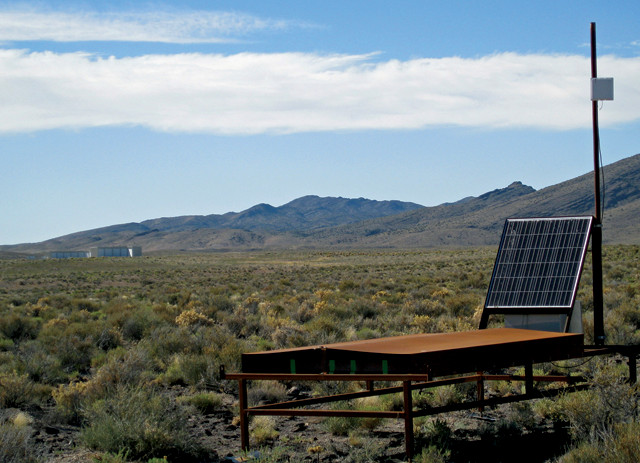
by Lucas Joel Friday, August 3, 2018

Surface detectors from the Telescope Array in Utah's western desert were used to detect gamma ray showers caused by lightning. Credit: John Matthews, University of Utah.
A handful of times between 2014 and 2016, an array of ground detectors placed in Utah’s western desert sensed something in thunderstorms that occasionally raged overhead: showers of gamma rays — the highest energy waves in the electromagnetic spectrum — occurring alongside lightning bolts. The observations, reported in a new study, mark the first time scientists spotted such gamma rays from the ground and reveal more about the relationship between lightning and gamma rays, potentially shedding light on some unanswered questions about lightning itself.
The gamma ray showers, also known as terrestrial gamma ray flashes (TGFs), were discovered serendipitously in 1994 by satellites instrumented to detect gamma rays produced by far-off astrophysical events like supernovae. Such showers had previously been observed only from satellites.
However, the immense size of the Telescope Array, which features more than 500 detectors spread over an area the size of New York City west of Delta, Utah, made it possible to spot the showers from Earth, says Rasha Abbasi, an astrophysicist at the University of Utah and lead author of the study in the Journal of Geophysical Research: Atmospheres. Because the bursts were detected from the ground, close to the storms, researchers could image them in greater detail than with satellite data. During the course of multiple storms, Abbasi and her team detected 10 downward-propagating TGF bursts, each of which only lasted a few microseconds.
Although the factors that cause such gamma ray showers are still unknown, the new work reveals that they happen in the first stage of a lightning strike. “The first stage is the step-leader stage,” Abbasi says. When a bolt initiates and begins branching toward the ground, it takes “one step to the left, [then] one step to the right.”
The gamma ray showers produced by the thunderclouds studied in the new research “are a byproduct of yet-unidentified acceleration mechanisms in our own atmosphere,” says Hamid Rassoul, a space physicist at the Florida Institute of Technology who was not involved in the study. “It is surprising that thunderstorms and lightning can do this at all,” he adds. “We don’t usually think of the atmosphere as a powerful source of high-energy particles.”
Now that it is clearer when gamma ray showers originate during lightning events, Abbasi says, researchers are “starting to zoom in on the mechanism of how the TGFs are produced.” Understanding the mechanism behind TGFs may help reveal fundamental details of how lightning itself is initiated — still a topic of debate among scientists, Abbasi says.
© 2008-2021. All rights reserved. Any copying, redistribution or retransmission of any of the contents of this service without the expressed written permission of the American Geosciences Institute is expressly prohibited. Click here for all copyright requests.